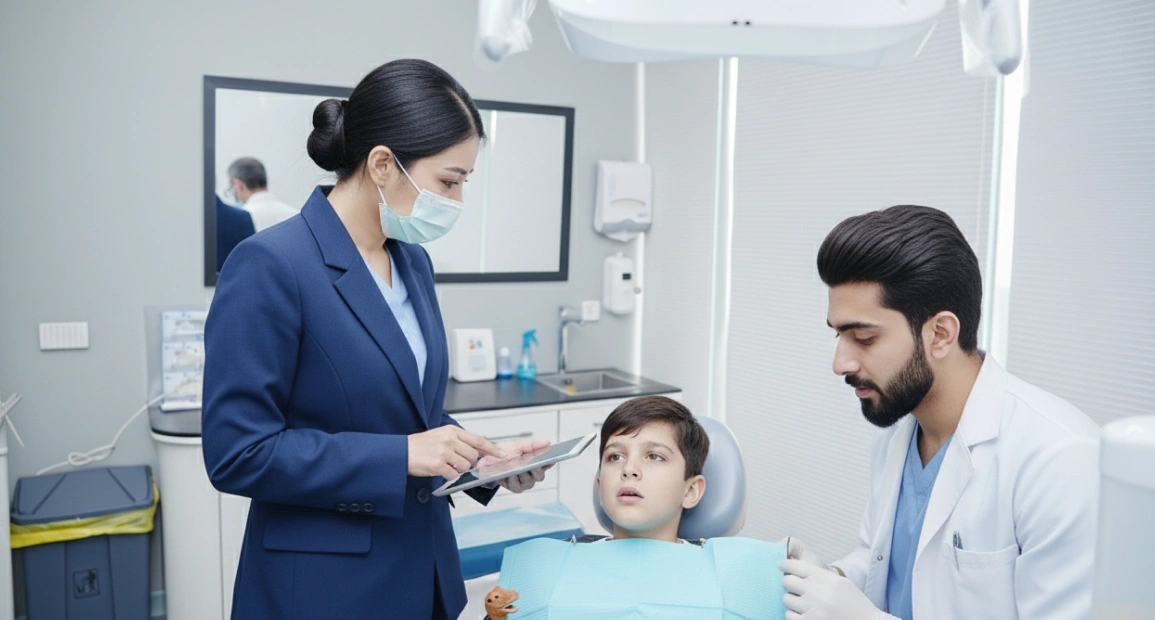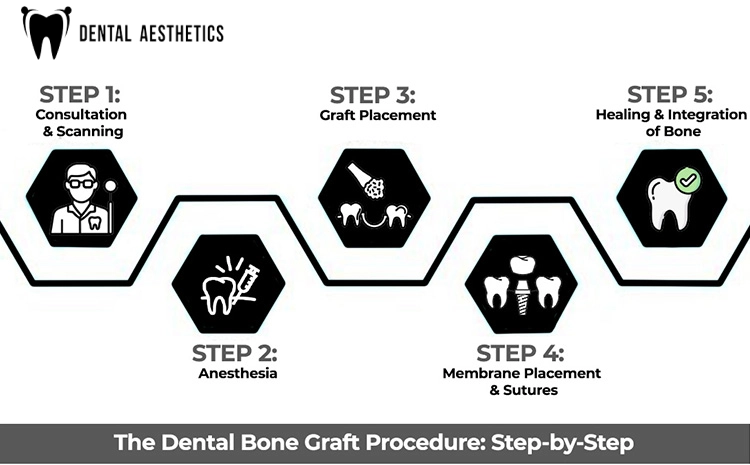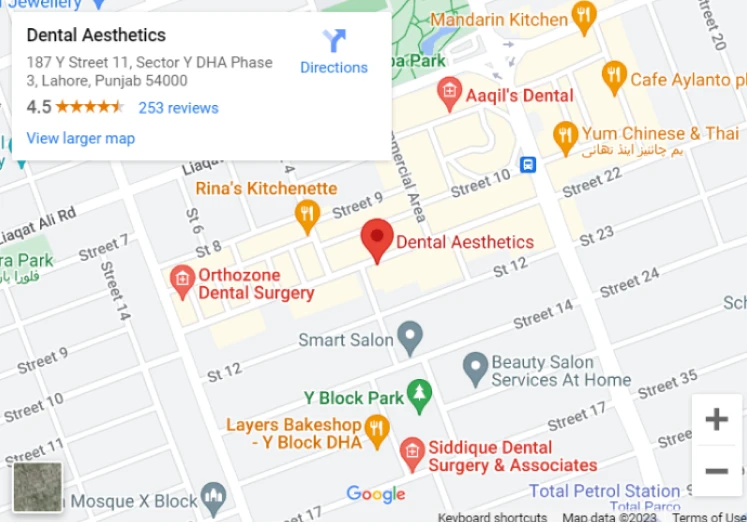Dental Bone Graft: Procedure, Cost & Recovery Guide in Lahore

November 14, 2025
Missing teeth, periodontal disease, or jawbone loss can compromise the building blocks of your smile. When bacteria destroy your dental bone, it doesn't just have aesthetic implications - it also affects the function of your mouth, your ability to eat, and whether you will be eligible for dental implants or not. That is when a dental bone graft is necessary.
At top-rated dental practices in DHA Lahore, such as Dental Aesthetics, advanced bone grafting procedures can help rebuild lost jawbone, restore structure and strength in your jaw, and prepare your mouth for durable treatments, such as tooth implants or dental bridges. It does not matter whether you have lost bone due to disease, trauma, or a past extraction; a bone graft for a tooth implant can give your smile a healthy and strong foundation again.
This guide will highlight everything you need to know regarding the dental bone graft process, cost, recovery, and why choosing an experienced dental bone grafting specialist in Lahore can help you achieve the best outcome.
What is a Dental Bone Graft?
A dental bone graft is a minor surgery that is intended to replace damaged, missing, or deficient bone in the jaw. Grafted material comes from your body or a bio-compatible source, and the grafted material initiates the natural bone regeneration process called osseointegration.
As bone tissue is created and incorporated with the graft material, the area will typically become strong enough for you to receive dental implants, restore the ability to chew, and maintain the function of your facial structure.
The body integrates the grafting material with the bone that is already there through a process called osseointegration. In short, osseointegration generates a strong, natural foundation for future restorations such as an implant or bridge.
Why Might Bone Grafting Be Necessary?
You may need to undergo bone grafting to place a dental implant, or when a tooth is extracted and bone grafting is done for any of the following reasons:
- To get ready for dental implants: Bone grafting may be needed for you to have the proper density to have a tooth implant placed.
- To prevent bone loss after extraction: Bone grafting immediately after a tooth is extracted is also called socket preservation, and it maintains the volume of bone immediately after tooth removal.
- To maintain facial aesthetics: Bone grafting will prevent a sunken-in appearance related to the resorption of your bone.
- To fix a defect in the bone: A defect can be caused by a cyst being removed, trauma to the area, or bone loss related to gum disease.
Types of Dental Bone Grafts
In the field of grafting, there are different forms of grafts, all of which your dentist will choose for your particular needs and treatment objectives. The table summarizes the different types:
| Type of Bone Graft | Source | Best For | Commonly Used In |
|---|---|---|---|
| Autogenous Graft | Taken from your own body (chin or hip) | Excellent biocompatibility | Large defects |
| Allograft | Donor bone (processed and sterilized) | Convenient and safe | Socket preservation |
| Xenograft | Bone from an animal source (usually bovine) | Lasting structure | Ridge augmentation |
| Synthetic Graft | Man-made materials (calcium phosphate) | No donor required | General bone support |

The Dental Bone Graft Procedure: Step-by-Step
Having an understanding of what occurs during a dental bone graft procedure will help you feel more at ease with any treatment you may be receiving.
Step 1: Consultation & Scanning
Your dentist will be able to assess your jawbone with either digital X-rays or a CBCT 3D scan to determine what bone is necessary and where more bone is needed.
Step 2: Anesthesia
You’ll be reassured to know that the entire process is pain-free with either a local anesthetic or light sedation.
Step 3: Graft Placement
The dentist will open the gum at the site to access the jawbone. The bone graft material is placed into the area requiring augmentation. If done at the time of extraction, this step is known as socket preservation.
Step 4: Membrane Placement & Sutures
Next, the dentist will put a thin protective layer, such as the protective membrane, over the graft and use sutures to close the area.
Step 5: Healing & Integration of Bone
Over the next several months, bone cells will grow and integrate with the graft, a process called osseointegration. Once complete, your jawbone will be ready for dental implants or other restorative treatments.
If you're feeling apprehensive about the procedure, the good news is that dental bone grafting is typically quick, comfortable, and safe as an outpatient treatment.
Specialized Bone Grafting Techniques
Depending on where there has been bone loss, the dentist may utilise specialized grafting techniques:
- Sinus Lift: This is a bone grafting procedure to add bone to the upper jaw adjacent to the molars and premolars. This is a common procedure prior to an implant in the upper jaw.
- Ridge Augmentation: This bone grafting procedure restores the natural contour to the jawline sustained a large volume of bone.
- Socket Preservation: This bone grafting method is performed immediately after dentition is lost in order to maintain the shape of the bone and prevent collapse.
- These procedures ensure that the bride provides adequate volume and support for dental implants or prosthetic restorations.
Bone Graft for Tooth Implant
If you have lost a tooth and are thinking about getting an implant, a bone graft for a tooth implant may be necessary to achieve a successful outcome in the long term. If there is insufficient bone density, implants cannot integrate successfully, leading to a greater likelihood of failing.
A bone graft before an implant generally requires 3-6 months of healing before the implant post can be placed. Some minor grafts can, however, occur at the same time as the implant surgery if bone loss is minimal.

Dental Bone Graft Cost in Lahore
The dental bone graft cost will vary based on factors such as the type of graft, the size of the area, and anything else, like PRF therapy or sinus lift. Always consult a dental bone graft specialist in Lahore who uses premium biocompatible materials and advanced imaging techniques to achieve accurate and long-lasting results.
| Type of Procedure | Estimated Cost (PKR) | Notes |
|---|---|---|
| Simple Bone Graft | 20,000 - 35,000 | For small areas or socket preservation |
| Ridge Augmentation | 35,000 - 60,000 | For contour rebuilding |
| Sinus Lift with Graft | 50,000 - 90,000 | Upper jaw prep before the implant |
| PRF Bone Graft Add-On | 10,000 - 20,000 | For healing and bone growth promotion |
Dental Bone Graft Aftercare and Recovery
Dental bone graft aftercare is very important in an effort to have an uneventful recovery. Adhering to the following instructions will facilitate the effective healing of your bone graft before dental implant surgery, offering you the best possible foundation for future dental treatment.
- Avoid any strenuous activity for at least 72 hours after the procedure. This reduces the risk of bleeding and promotes healing and recovery.
- Take medications, especially prescription painkillers and antibiotics, before you leave the clinic, particularly while the anesthetic is still wearing off. Don't wait until you're in pain to take the painkillers; doing so will only prolong your discomfort.
- Avoid using a straw or spitting for 24 hours; action may disturb the graft. Stick to soft foods or puréed food for at least 72 hours. For additional comfort, try ice cream or smoothies, but make sure the material is just cold and does not 'freeze' the graft.
- You can notice some swelling for the first 48-72 hours, which is normal. Sleep with your head elevated to reduce swelling, and contact your dentist and their team immediately if the swelling persists so they can help address your concerns.
- It's also important to avoid smoking, drinking alcoholic beverages, and, if possible, taking anti-inflammatory medications for the first few days after the procedure. Following your dental surgeon's aftercare instructions carefully is essential, including scheduling your follow-up appointment for a check-up.
Aesthetic Advantages of Bone Grafting
There's also an important role for dental bone grafts beyond the restoration of your health.
| Advantages | Explanation |
|---|---|
| Restores your facial symmetry | Minimizes sagging and creates youthful contours |
| Supports your smile aesthetic | Creates a base where dental implants or crowns can be properly aligned |
| Contributes to bite balance | Helps stabilize your jaw and improve comfort |
| Reduces long-term complications | Prevents teeth shifting and dental misalignment |
Reasons to See a Dental Bone Graft Specialist in Lahore
If you are choosing to see a dental bone graft in Lahore, be sure to choose an experienced specialist who uses:
- Advanced anatomy imaging (CBCT 3D scans)
- Use of high-quality materials (autogenous, xenograft, or synthetic graft)
- PRF technology to enhance healing speed
- A professional specializes in sinus lift and ridge augmentation
- An open discussion on challenges or cost, or timeline to complete your dental bone graft
Conclusion: Restore your smile with confidence
A strong jawbone is essential for an attractive, long-lasting smile. Whether you have lost bone due to an extraction, injury, or gum disease, bone grafting is a way to restore function and esthetics, prepping the mouth for eventual tooth implants or cosmetic improvements safely and predictably.
Lahore's modern dental bone graft specialists combine innovative technology with gentle surgical methods and the best materials to provide predictable, natural-looking outcomes. Procedures may be socket preservation, sinus lifts, or PRF-augmented bone grafts. They will restore your bone and your confidence.
If you need a dental bone graft for an implant or want to restore the contours of your natural face, inquire with a great dental practice in DHA, such as Dental Aesthetics. After a few months of healing, you may get a lifetime of strong, stable, aesthetically pleasing smiles.
Frequently Asked Questions (FAQs) about Dental Bone Grafts in Lahore
Q1. What is a dental bone graft?
A dental bone graft is a procedure to add or restore bone in the jaw to help support tooth implants or maintain structure after tooth loss. The procedure places bone material (natural or synthetic) into an area of deficiency to stimulate new bone growth.
Q2. Does bone grafting hurt?
The surgery is performed under anaesthesia, so there is no pain that occurs. Following the grafting procedure, mild soreness is expected, and your doctor will prescribe pain medication to manage any discomfort. The majority of patients describe a very comfortable recovery.
Q3. How long does a bone graft last?
Once healing occurs, the bone graft becomes integrated for life through a process called osseointegration and provides stability to a bone implant or restoration for a lifetime.
Q4. How much does bone grafting cost in Lahore?
The cost of dental bone grafting in Lahore can run anywhere from PKR 20,000 to PKR 100,000, depending on the type of graft, complexity, and whether other procedures are done, such as sinus lifts or PRF bone grafts.
Q5. What is the best bone graft for dental implants?
The best bone graft depends on your individual case. Most specialists prefer the usage of an autogenous graft from your own bone because they tend to integrate best. Still, xenografts and synthetic bone grafts can also be very effective and biocompatible.
Q6. How long after a bone graft can I have a dental implant?
In most cases, implants are done 3 to 6 months after the grafting has been completed or once your new bone mass has integrated; however, in the case of mild grafting, the implants can sometimes be placed at the same time.


